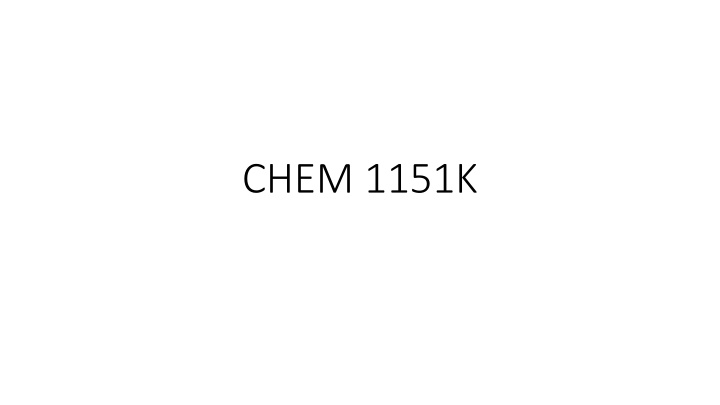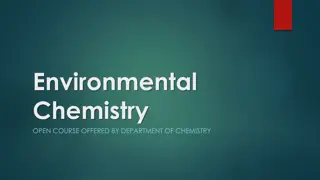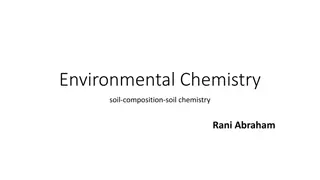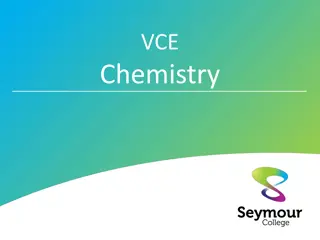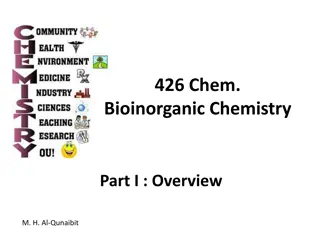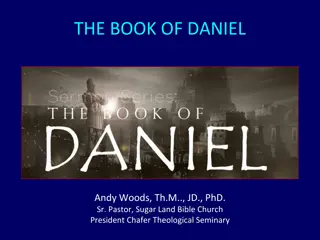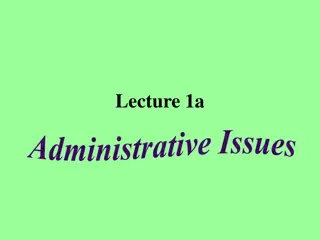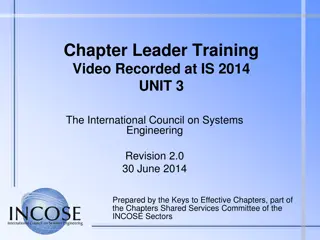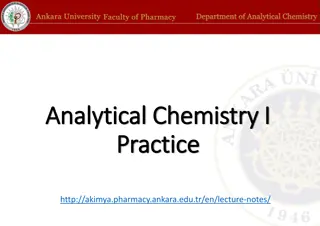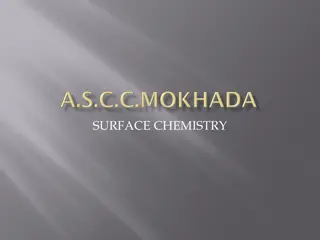Chemistry 1151K Course Overview and Chapters Summary
Upon completion of the CHEM 1151K course, students will apply the scientific method to investigate chemical questions in allied health, utilize dimensional analysis to solve quantitative problems, communicate effectively using chemical terminology and symbols, describe the behavior of biochemical solutions, and relate chemical concepts to processes of biochemical interest. The course covers various chapters including Chemistry in Our Lives, Chemistry and Measurements, Energy and Matter, Atoms and Elements, and Nuclear Chemistry.
Download Presentation

Please find below an Image/Link to download the presentation.
The content on the website is provided AS IS for your information and personal use only. It may not be sold, licensed, or shared on other websites without obtaining consent from the author.If you encounter any issues during the download, it is possible that the publisher has removed the file from their server.
You are allowed to download the files provided on this website for personal or commercial use, subject to the condition that they are used lawfully. All files are the property of their respective owners.
The content on the website is provided AS IS for your information and personal use only. It may not be sold, licensed, or shared on other websites without obtaining consent from the author.
E N D
Presentation Transcript
Overview Upon completion of this course, students will: 1) apply the scientific method to investigate chemical questions within the field of allied health; 2) apply dimensional analysis to solve quantitative problems; 3) clearly communicate orally and in writing using chemical terminology and symbology and through graphs, charts and tables; 4) utilize the fundamental principles of chemical structure and reactivity to describe the behavior of solutions of biochemical interest; 5) relate the chemical concepts of equilibrium, kinetics and reactions to processes of biochemical interest, apply standard laboratory policies, procedures and safety practices when performing experiments
Chapter 1. Chemistry in Our Lives Chapter 1. Chemistry in Our Lives Scientific method Nature of Chemistry Review of the mathematical skills
Chapter 2. Chemistry and Measurements Chapter 2. Chemistry and Measurements Units of Measurement Scientific Notation Measured Numbers and Significant Figures Significant Figures in Calculations Prefixes and Equalities Writing Conversion Factors Problem Solving Density
Chapter 3. Energy and Matter Chapter 3. Energy and Matter Temperature Classification of Matter States and Properties of Matter Specific Heat Energy and Nutrition Energy and types of Energy
Chapter 4. Atoms and Elements Chapter 4. Atoms and Elements Elements and Symbols The Periodic Table and The Atom Atomic Number and Mass Number Isotopes and Atomic Mass Electron Arrangement in Atoms Orbital Diagrams and Electron Configurations Trends in Periodic Properties
Chapter 5. Nuclear Chemistry Chapter 5. Nuclear Chemistry Natural Radioactivity Nuclear Reactions Radiation Measurement Half-Life of a Radioisotope Medical Applications Nuclear Fission and Fusion
Chapter 6. Compounds and their Bonds Chapter 6. Compounds and their Bonds Ions: Transfer of Electrons Ionic Compounds Naming and Writing Ionic Formulas Polyatomic Ions Covalent Compounds: Sharing Electrons Naming and Writing Covalent Formulas Electronegativity and Bond Polarity Shapes and Polarity of Molecules Attractive Forces in Compounds
Chapter 7. Chapter 7. Chemical Reactions and Quantities Equations for Chemical Reactions Types of Reactions Oxidation Reduction Reactions The Mole, Molar Mass Mole Relationships in Chemical Equations Mass Calculations for Reactions Percent Yield and Limiting Reactants Energy Changes in Chemical Reactions
Chapter 8. Gases Chapter 8. Gases Properties of Gases and Gas Pressure Pressure and Volume Temperature and Volume, Temperature and Pressure , The Combined Gas Law Volume and Moles The Ideal Gas Law Partial Pressures
Chapter 9. Solutions Chapter 9. Solutions Solutions Electrolytes and Nonelectrolytes Solubility Solution Concentration Dilution of Solutions and Solution Reactions Properties of Solutions
Chapter 11. Acids and Bases Chapter 11. Acids and Bases Acids and Bases Strengths of Acids and Bases Ionization of Water The pH Scale Reactions of Acids and Bases Buffers
CHEM 1152K Course Outcome Goals (1) apply the concepts of bonding, stereochemistry, and 3-dimensional arrangement of atoms in molecules and their resulting influence on molecular properties (2) apply the fundamental language and nomenclature of organic chemistry and biochemistry (3) describe, predict, and apply fundamental organic chemistry and biochemistry mechanisms, reactions, and processes (4) describe and apply fundamental concepts of organic chemistry to the structure and function of biologically relevant molecules and processes (5) effectively and clearly communicate scientific information in written and oral form (6) collect, present, and analyze scientific data gathered through experiment
Basic structure This course is basically broken down into 2 parts Organic chemistry Biochemistry Currently MOST instructors focus on the organic chemistry parts for the first 10-11 weeks (with some biological aspects thrown in). Last 4 weeks is biochemistry. There are discussions about changing this format!
Chapters 12-14 (Weeks 1-5) Chapter 12 Hydrocarbons (Alkenes, Alkanes, Alkynes, Aromatic Compounds, Cis/Trans Isomers, Polymers) Chapter 13 Alcohols, Phenols, and Ethers Chapter 14 Aldehydes and Ketones Naming Drawing Properties Reactions The end of Ch. 14 we start talking about chirality and Fisher projections.
Chapter 15 Carbohydrates (Week 6) D and L Families of Sugars Drawing sugar molecules Fisher projections (open form) and Haworth structures (cyclic form) Important monosaccharides Glucose, Galactose, Fructose Important disaccharides Maltose, Sucrose, and Lactose Important polysaccharides Starch (Amylose and Amylopectin), Cellulose, Glycogen
Chapters 16-18 (Weeks 7-11) Chapter 16 Carboxylic Acids and Esters Chapter 17 Lipids (Fatty Acids and Steroids) Briefly discuss cell membranes Chapter 18 Amines and Amides Briefly discuss neurotransmitters Naming Drawing Properties Reactions
Chapter 19 Amino acids and Proteins (Week 12) Classification of Amino Acids Stereoisomers (D and L) Zwitterions Formation of Peptides Primary, secondary, tertiary, and quaternary protein structure Hydrolysis and Denaturation Enhanced topics include protein synthesis, metabolism, and degradation
Chapter 20 Enzymes and Vitamins (Week 13-14) Enzymes and enzyme action Classification of Enzymes Factors affecting Enzymes Activity Enzyme Inhibition Enhanced topics include regulation of enzyme activity and enzyme cofactors and vitamins
BIOL 2451K Anatomy & Physiology I
Chemistry (review?) Periodic Table Water Molecules and Ions Acids / Bases Organic Macromolecules
Cell Plasma membrane Transport Cytoplasmic organelles Nucleus Overarching Concepts: Chemistry molecules and macromolecules Na+/K+, chemical gradients, osmosis and diffusion
Tissues Epithelial Connective Muscular Neural Overarching Concepts:
Integumentary System Skin Hair Nails Glands Function: Protection Overarching Concepts: Body temperature regulation
Skeletal System Bones Cartilages Ligaments Physiology: bone remodeling Overarching Concepts: Blood calcium regulation
Muscular System Skeletal Muscles (mainly) Tendons Physiology: contraction Overarching Concepts: Glycolysis (aerobic respiration) Action potential Na+/K+
Nervous System Brain Spinal cord nerves Physiology: communication & regulation Overarching Concepts: Action potential Na+/K+ Sympathetic & Parasympathetic system responses reflexes
BIOL 2451K Anatomy & Physiology II
Endocrine System Glands Hormones Physiology: communication & regulation Overarching Concepts: Regulation of blood calcium, body temperature, blood pressure, volume Sympathetic & Parasympathetic system responses
Cardiovascular System Heart Blood Blood Vessels Physiology: circulation Overarching Concepts: Regulation of body temperature, blood pressure, volume Sympathetic & Parasympathetic system responses Diffusion & osmosis
Lymphatic / Immune System Lymphatic vessels Lymphocytes, Lymph nodes (etc.) Physiology: Immune defense Overarching Concepts: Innate / adaptive immunity Antigens and pathogens T cells, B cells, antibodies Temperature - fever
Respiratory System Lungs Respiratory Tract Physiology: Gas exchange (O2, CO2) Overarching Concepts: Internal respiration Diffusion of gases Acid-Base Balance Cilia
Digestive System Digestive Tract Liver, Pancreas Physiology: Nutrition and excretion Overarching Concepts: Organic molecules and macromolecules Enzymes Membrane transport Regulation of blood glucose Hormones
Urinary System Kidneys Urinary Tract Physiology: Excretion of wastes Overarching Concepts: Regulation of blood pressure and fluid volumes Hormones Na+/K+ Acid-base balance Bicarbonate buffer system
Reproductive System Gonads Reproductive Tracts Physiology: Sex cells and sex hormones Overarching Concepts: Mitosis, Meiosis Hormones Cilia
Common Themes in A&P (1 and 2) Homeostasis / Regulation Body temperature Cellular Structure & Function Chemical Macromolecules (carbs, lipids, proteins) Ions: Na+, K+, H+, Ca2+ Autonomic Nervous System / Reflexes
BIOL 2516K Microbiology for Health Sciences Course Goals and Topics Julie Shearer Wendy Dustman
Course Goals 1. demonstrate knowledge of the fundamentals of the field of microbiology including its history, basic microscopy techniques and the role of microbes in both health and disease describe prokaryotic cellular structure and functions discuss the molecular basis of microbial metabolism, growth, genetics and pathogenesis discuss the diversity of microorganisms and viruses demonstrate knowledge of the techniques of microbial control including sterilization, disinfection and antimicrobial therapy discuss host-microbe interactions including epidemiology, nonspecific/specific host defense and immunology identify the major medically important organisms and relate them to the diseases they cause demonstrate competence in common staining and aseptic techniques used to study microorganisms in the laboratory 2. 3. 4. 5. 6. 7. 8.
Chapters/topics Ch. 1 Intro and history of microbiology (goal 1) basics: domains, what are microbes, prokaryotes vs eukaryotes, importance/uses of microbes history: discovery of microbes, disproving spontaneous generation, association of microbes with disease Ch. 3 Microscopy (goal 1) types, resolution, staining (Gram) Ch. 4 Anatomy of prokaryotes (small amount eukaryotes) (goal 2) morphologies/arrangements membranes, cell wall (Gram+/-), flagella, pili, endospores, capsules Ch. 10 systematics (goal 4) domains and kingdoms endosymbiotic theory
Chapters/topics Ch. 5 Metabolism (goal 3) review of enzymes, redox cellular respiration glycolysis, transition/prep, Krebs, ETC substrate-level phosphorylation and oxidative phosphorylation fermentation Ch. 6 Microbial growth (goals 3 and 4) cell cycle, batch culture stages physical and chemical growth requirements (temp, pH, elements, etc.) classifications based on growth requirements (thermophile, aerotolerant, etc.) methods to measure growth
Chapters/topics Ch. 7 Growth control (goal 5) static vs cidal agents; antiseptics/disinfectants/sterilants physical control (types of heat, radiation, etc) chemical control Ch. 8 Microbial genetics (goal 3) bidirectional replication transcription and translation mutations horizontal gene transfer (typical and atypical conjugation, transduction, transformation) recombination (homologous and transposons)
Chapters/topics Ch. 13 Viruses (goal 6 and some goal 7) general characteristics and taxonomy bacteriophages animal viruses types of viruses; specific topics (influenza antigenic shift/drift, HIV pathogenesis) other acellular agents (viroids, prions and prion diseases) Ch. 14 Epidemiology (goal 6) terms (endemic, prevalence, zoonosis, septicemia, herd immunity, etc) roles of commensal microbiota, opportunistic infections routes of transmission Ch. 15 Pathogenesis (goals 3 and 6) basic cycle of pathogenesis (reservoir, entry, disease, exit) virulence factors (adhesins, toxins, etc.) ID50, LD50
Chapters/topics Ch. 20 Antimicrobial Drugs (goal 5) history and selective toxicity mechanisms of action/drug targets (cell wall, membrane, protein synthesis, etc.) antiviral drugs Ch. 16 Non-specific/Innate Immunity (goal 6) blood/immune cells phagocytosis, complement system, inflammation cytokines, fever Ch. 17, 18, 19 Specific/Adaptive Immunity (goal 6) humoral pathway (TH and B cells) cell-mediated pathway (TH and TC cells) specific topics (vary by section/instructor): hypersensitivity, autoimmunity, immunodeficiency, vaccines
Chapters/topics Various chapters and other sources: Microbial Diseases (goal 7) variety of microbial diseases could be covered here examples: TB, diphtheria, staphylococcal food intoxication, etc. most sections cover HIV and influenza when covering viruses
